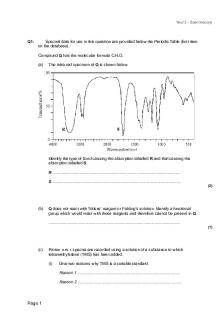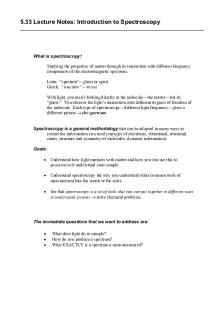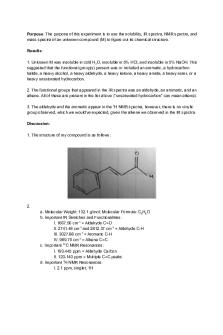Spectroscopy Questions PDF

| Title | Spectroscopy Questions |
|---|---|
| Author | Ben Roberts |
| Course | HSC Chemistry - Year 12 |
| Institution | Higher School Certificate (New South Wales) |
| Pages | 116 |
| File Size | 3.8 MB |
| File Type | |
| Total Downloads | 274 |
| Total Views | 636 |
Summary
Download Spectroscopy Questions PDF
Description
Year 2 - Spectroscopy
Q1.
Spectral data for use in this question are provided below the Periodic Table (first item on the database). Compound Q has the molecular formula C H O 4
(a)
8
2
The infra-red spectrum of Q is shown below.
Identify the type of bond causing the absorption labelled R and that causing the absorption labelled S. R .................................................................................................................. S ................................................................................................................... (2)
(b)
Q does not react with Tollens’ reagent or Fehling’s solution. Identify a functional group which would react with these reagents and therefore cannot be present in Q. ...................................................................................................................... (1)
(c)
Proton n.m.r. spectra are recorded using a solution of a substance to which tetramethylsilane (TMS) has been added. (i)
Give two reasons why TMS is a suitable standard. Reason 1 ............................................................................................ Reason 2 .............................................................................................
Page 1
Year 2 - Spectroscopy
(ii)
Give an example of a solvent which is suitable for use in recording an n.m.r. spectrum. Give a reason for your choice. Solvent ................................................................................................ Reason ................................................................................................ (4)
(d)
The proton n.m.r. spectrum of Q shows 4 peaks. The table below gives δ values for each of these peaks together with their splitting patterns and integration values.
δ/ppm
2.20
2.69
3.40
3.84
Splitting pattern
singlet
triplet
singlet
triplet
Integration value
3
2
1
2
What can be deduced about the structure of Q from the presence of the following in its n.m.r. spectrum? (i)
The singlet peak at δ = 2.20 .............................................................................................................
(ii)
The singlet peak at δ = 3.40 .............................................................................................................
(iii)
Two triplet peaks ............................................................................................................. (3)
(e)
Page 2
Using your answers to parts (a), (b) and (d), deduce the structure of compound Q.
Year 2 - Spectroscopy
(1) (Total 11 marks)
Q2.
(a)
Draw the structure of ethyl propanoate.
(1)
(b)
Name and outline a mechanism for the formation of ethyl propanoate from propanoyl chloride and ethanol. Name of mechanism .................................................................................... Mechanism
(5)
(c)
The mass spectrum of ethyl propanoate contains a major peak at m/z = 57. Write an equation showing the fragmentation of the molecular ion to form the species responsible for the peak at m/z = 57. Show the structure of this species in your answer. ...................................................................................................................... (2)
Page 3
Year 2 - Spectroscopy
(d)
Draw the structure of another ester which is an isomer of ethyl propanoate and which gives a major peak at m/z = 71 in its mass spectrum.
(1) (Total 9 marks)
Q3.
Page 4
Three sections of the proton n.m.r. spectrum of CH CHClCOOH are shown below. 3
Year 2 - Spectroscopy
(a)
Name the compound CH CHClCOOH 3
...................................................................................................................... (1)
(b)
Explain the splitting patterns in the peaks at δ 1.72 and δ 4.44 ...................................................................................................................... ...................................................................................................................... ...................................................................................................................... (2)
(c)
Predict the splitting pattern that would be seen in the proton n.m.r. spectrum of the isomeric compound ClCH CH COOH 2
2
...................................................................................................................... ...................................................................................................................... (1)
(d)
The amino acid alanine is formed by the reaction of CH CHClCOOH with an excess of ammonia. The mechanism is nucleophilic substitution. Outline this mechanism, showing clearly the structure of alanine. 3
(5)
(e)
The amino acid lysine has the structure
Draw structures to show the product formed in each case when lysine reacts with
Page 5
Year 2 - Spectroscopy
(i)
an excess of aqueous HCl,
(ii)
an excess of aqueous NaOH,
(iii)
another molecule of lysine.
(3) (Total 12 marks)
Q4.
The conversion of compound A into compound B can be achieved in two steps as shown below.
Page 6
Year 2 - Spectroscopy
The intermediate compound, X, has an absorption at 1650 cm in its infra-red spectrum. –1
(a)
Identify compound X. Explain your answer. (2)
(b)
For each step in this conversion, give the reagents and essential conditions required and outline a mechanism. (11)
(c)
Show how the number of peaks in their proton n.m.r. spectra would enable you to distinguish between compounds A and B. (2) (Total 15 marks)
Q5.
(a) Describe, by giving reagents and stating observations, how you could distinguish between the compounds in the following pairs using a simple test-tube reaction for each pair.
(i)
(ii)
(iii) (8)
(b)
Page 7
State how compounds E and F in part (a)(iii) above could be distinguished by their
Year 2 - Spectroscopy
infra-red spectra, without using the fingerprint region. Explain how fingerprinting is used to identify a compound. (3)
(c)
Suggest the structure of the fragment responsible for the major peak in the mass spectrum of compound E and state its m/z value. Write an equation showing the formation of this fragment from the molecular ion. (4) (Total 15 marks)
Q6.
Page 8
The proton n.m.r. spectrum of compound X is shown below.
Year 2 - Spectroscopy
Compound X, C H O , contains both a ketone and an ester functional group. The measured integration trace for the peaks in the n.m.r. spectrum of X gives the ratio shown in the table below. 7
Page 9
12
3
Year 2 - Spectroscopy
Chemical shift, δ/ppm
4.13
2.76
2.57
2.20
1.26
Integration ratio
0.8
0.8
0.8
1.2
1.2
Refer to the spectrum, the information given above and the data below the Periodic Table provided to answer the following questions. (a)
How many different types of proton are present in compound X? ...................................................................................................................... (1)
(b)
What is the whole-number ratio of each type of proton in compound X? ...................................................................................................................... (1)
(c)
Draw the part of the structure of X which can be deduced from the presence of the peak at δ2.20. ...................................................................................................................... (1)
(d)
The peaks at δ4.13 and δ1.26 arise from the presence of an alkyl group. Identify the group and explain the splitting pattern. Alkyl group .................................................................................................... Explanation ................................................................................................... ...................................................................................................................... ...................................................................................................................... (3)
(e)
Draw the part of the structure of X which can be deduced from the splitting of the peaks at δ2.76 and δ2.57. ...................................................................................................................... (1)
(f)
Page 10
Deduce the structure of compound X.
Year 2 - Spectroscopy
...................................................................................................................... (2) (Total 9 marks)
Q7.
Use the data given on the back of the Periodic Table (PT) to help you answer this question. Compounds A to G are all isomers with the molecular formula C H O 6
(a)
12
2
Isomer A, C H O , is a neutral compound and is formed by the reaction between compounds X and Y in the presence of a small amount of concentrated sulphuric acid. X and Y can both be formed from propanal by different redox reactions. X has an absorption in its infra-red spectrum at 1750 cm . Deduce the structural formulae of A, X and Y. Give suitable reagents, in each case, for the formation of X and Y from propanal and state the role of concentrated sulphuric acid in the formation of A. 6
12
2
–1
(7)
(b)
Isomers B, C, D and E all react with aqueous sodium carbonate to produce carbon dioxide. Deduce the structural formulae of the three isomers that contain an asymmetric carbon atom. The fourth isomer has only three singlet peaks in its proton n.m.r. spectrum. Deduce the structural formula of this isomer and label it E. (4)
(c)
Isomer F, C H O , has the structural formula shown below, on which some of the protons have been labelled. 6
12
2
A proton n.m.r. spectrum is obtained for F. Using Table 1 at the back of the Periodic Table (PT), predict a value of δ for the protons labelled a and also for those labelled b. State and account for the splitting patterns of the peaks assigned to the protons a and b. (6)
(d)
Isomer G, C H O , contains six carbon atoms in a ring. It has an absorption in its infra-red spectrum at 3270 cm and shows only three different proton environments 6
12
2
–1
Page 11
Year 2 - Spectroscopy
in its proton n.m.r. spectrum. Deduce a structural formula for G. (2) (Total 19 marks)
Q8.
Compound Q has the molecular formula C H ClO and does not produce misty fumes when added to water. 4
(a)
7
The infra-red spectrum of Q contains a major absorption at 1724 cm . Identify the bond responsible for this absorption. –1
...................................................................................................................... (1)
(b)
The mass spectrum of Q contains two molecular ion peaks at m/z = 106 and m/z = 108. It also has a major peak at m/z = 43. (i)
Suggest why there are two molecular ion peaks. .............................................................................................................
(ii)
A fragment ion produced from Q has m/z = 43 and contains atoms of three different elements. Identify this fragment ion and write an equation showing its formation from the molecular ion of Q. Fragment ion ....................................................................................... Equation .............................................................................................. (3)
(c)
The proton n.m.r. spectrum of Q was recorded. (i)
Suggest a suitable solvent for use in recording this spectrum of Q. .............................................................................................................
(ii)
Page 12
Give the formula of the standard reference compound used in recording proton n.m.r. spectra.
Year 2 - Spectroscopy
............................................................................................................. (2)
(d)
The proton n.m.r. spectrum of Q shows three peaks. Complete the table below to show the number of adjacent, non-equivalent protons responsible for the splitting pattern. Peak 1
Peak 2
Peak 3
Integration value
3
3
1
Splitting pattern
doublet
singlet
quartet
Number of adjacent, non-equivalent protons
1
(1)
(e)
Using the information in parts (a), (b) and (d), deduce the structure of compound Q.
(1)
(f)
A structural isomer of Q reacts with cold water to produce misty fumes. Suggest a structure for this isomer.
(1) (Total 9 marks)
Page 13
Year 2 - Spectroscopy
Q9.
(a) Ester X, CH CH COOCH , can be produced by the reaction between propanoyl chloride and methanol. Name X and outline a mechanism for this reaction. Name the mechanism involved. 3
2
3
(6)
(b)
The proton n.m.r. spectrum of X is shown below together with that of an isomeric ester, Y. Deduce which of Spectrum 1 and Spectrum 2 is that obtained from X. Use Table 1 on the Data Sheet and the integration data on the spectra to help you to explain your deduction. Suggest a structure for Y.
(4) (Total 10 marks)
Page 14
Year 2 - Spectroscopy
Q10.
Compounds C and D, shown below, are isomers of C H O 5
C (a)
10
D
Name compound C. ...................................................................................................................... (1)
(b)
Use Table 2 on the Data Sheet to help you to answer this question. (i)
Suggest the wavenumber of an absorption which is present in the infra-red spectrum of C but not in that of D. .............................................................................................................
(ii)
Suggest the wavenumber of an absorption which is present in the infra-red spectrum of D but not in that of C. ............................................................................................................. (2)
(c)
Deduce the number of peaks in the proton n.m.r. spectrum of C. ...................................................................................................................... (1)
(d)
Page 15
Identify a reagent that you could use to distinguish between C and D. For each of C and D, state what you would observe when the compound is treated with this
Year 2 - Spectroscopy
reagent. Reagent ....................................................................................................... Observation with C ....................................................................................... Observation with D ....................................................................................... (3)
(e)
Compound E, CH CH CH CH CHO, is also an isomer of C H O 3
2
2
2
5
10
Identify a reagent which will react with E but not with C or D. State what you would observe when E is treated with this reagent. Reagent ....................................................................................................... Observation with E ....................................................................................... (2) (Total 9 marks)
Q11.
(a) Describe how propanal, CH CH CHO, and propanone, CH COCH , can be distinguished using 3
2
(i)
a chemical test and
(ii)
the number of peaks in their proton n.m.r. spectra.
3
3
(5)
(b)
Compound Z can be produced by the reaction of compound X with compound Y as shown in the synthesis outlined below.
Identify compounds X and Y. For each of the three steps in the synthesis, name the type of reaction involved and give reagents and conditions. Equations are not required.
Page 16
Year 2 - Spectroscopy
(10) (Total 15 marks)
Q12.
Compound U is shown below.
(a)
Name compound U. ...................................................................................................................... (1)
(b)
(i)
State why the mass spectrum of U contains two molecular ion peaks. .............................................................................................................
(ii)
Give the m/z values of these two peaks. ............................................................................................................. ............................................................................................................. (2)
(c)
Name and outline a mechanism for the reaction of U with CH OH 3
Name of mechanism .................................................................................... Mechanism
Page 17
Year 2 - Spectroscopy
(5) (Total 8 marks)
Q13.
Each of the parts (a) to (e) below concerns a different pair of isomers. Draw one possible structure for each of the species A to J, using Table 2 on the Data Sheet where appropriate. (a)
Compounds A and B have the molecular formula C H A decolourises bromine water but B does not. 5
A
10
B
(2)
(b)
Compounds C and D have the molecular formula C H O 2
4
2
Each has an absorption in its infra-red spectrum at about 1700 cm but only D has a broad absorption at 3350 cm –1
–1
C
D
(2)
(c)
Page 18
Compounds E and F are esters with the molecular formula C H O 5
10
2
Year 2 - Spectroscopy
The proton n....
Similar Free PDFs

Spectroscopy Questions
- 116 Pages

Spectroscopy
- 5 Pages

Mass Spectroscopy
- 14 Pages

Spectroscopy Lab
- 2 Pages

Raman Spectroscopy
- 22 Pages

Infrared Spectroscopy
- 3 Pages

Spectroscopy+EC 0002a
- 1 Pages

Introduction to Spectroscopy 1
- 3 Pages

Atomic Absorption Spectroscopy
- 271 Pages

Spectroscopy exercises SL
- 6 Pages

Topic 4 :Spectroscopy -Exercises
- 2 Pages

Atomic Absorption Spectroscopy
- 9 Pages

Atomic Absorption Spectroscopy
- 1 Pages

UV Spectroscopy - Summary
- 4 Pages
Popular Institutions
- Tinajero National High School - Annex
- Politeknik Caltex Riau
- Yokohama City University
- SGT University
- University of Al-Qadisiyah
- Divine Word College of Vigan
- Techniek College Rotterdam
- Universidade de Santiago
- Universiti Teknologi MARA Cawangan Johor Kampus Pasir Gudang
- Poltekkes Kemenkes Yogyakarta
- Baguio City National High School
- Colegio san marcos
- preparatoria uno
- Centro de Bachillerato Tecnológico Industrial y de Servicios No. 107
- Dalian Maritime University
- Quang Trung Secondary School
- Colegio Tecnológico en Informática
- Corporación Regional de Educación Superior
- Grupo CEDVA
- Dar Al Uloom University
- Centro de Estudios Preuniversitarios de la Universidad Nacional de Ingeniería
- 上智大学
- Aakash International School, Nuna Majara
- San Felipe Neri Catholic School
- Kang Chiao International School - New Taipei City
- Misamis Occidental National High School
- Institución Educativa Escuela Normal Juan Ladrilleros
- Kolehiyo ng Pantukan
- Batanes State College
- Instituto Continental
- Sekolah Menengah Kejuruan Kesehatan Kaltara (Tarakan)
- Colegio de La Inmaculada Concepcion - Cebu

